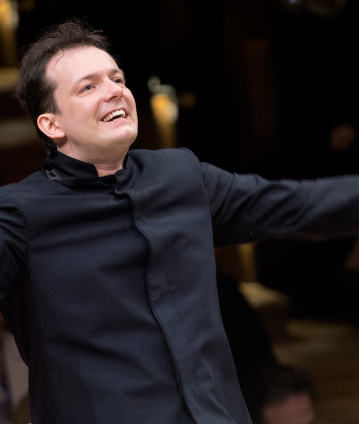Andris Nelsons conducts Strauss’s “Alpine Symphony”

Richard Strauss’ spectacularly orchestrated Alpine Symphony, a showpiece of the Berliner Philharmoniker since the days of Herbert von Karajan, was given its premiere in Berlin on 28 October 1915. The orchestra celebrated the 100th anniversary of this event with a colourful and expressive performance under the baton of Andris Nelsons. The programme also includes Shostakovich’s disturbing, virtuoso Violin Concerto No. 1 with Baiba Skride as the soloist.
Richard Strauss is said to have claimed that he could depict even a glass of beer in music so accurately that his listeners would be able to tell whether it was a Pilsner or a Kulmbacher. Well, the composer’s Alpine Symphony, premiered in Berlin in 1915, is not about beer: it is the musical representation of an alpine mountain hike with all its beauties and dangers. Strauss had originally planned a four-movement symphony based on Friedrich Nietzsche’s polemic book The Antichrist. But while composing it he discovered that the musical themes flowed from his pen “just as a cow gives milk”. So Strauss abandoned the planned project, devoted himself completely to the exuberant wealth of musical ideas, and wrote a highly virtuoso mood painting that brings 130 musicians to the stage – without an ideological superstructure.
Soviet composers were not supposed to devote themselves to what they did with such abandon – that, at least, was the opinion of the Stalinist cultural authorities, who had more or less concrete ideas of how artists were intended to contribute to building a socialist society. Dmitri Shostakovich was repeatedly reprimanded for the allegedly “formalistic” and “foreign” tendencies of his music, including in 1948. As a consequence Shostakovich’s A minor Violin Concerto, completed that year, lay in the drawer for seven years: only Stalin’s death and the political thaw that began in the USSR as a result started the process for a delayed premiere of the work on 29 October 1955 in Leningrad.
With this programme full of contrasts, the Berliner Philharmoniker enjoy a reunion with two long-standing musical partners: Andris Nelsons is responsible for the musical direction; the solo part in Shostakovich’s Violin Concerto – technically and emotionally difficult to handle – is played by the violinist Baiba Skride, who, like Nelsons, was born in Latvia.
© 2015 Berlin Phil Media GmbH
Related interviews